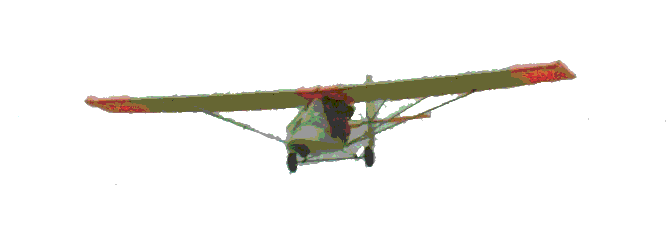MICROLIGHT FLYING
 The UK CAA definition of a Microlight was revised in December 2001 :-
The UK CAA definition of a Microlight was revised in December 2001 :-
"An aeroplane designed to carry not more than two persons which has:
(a) a maximum total weight authorised not exceeding:
- <300kg for a single seat landplane, (or 390kg for a single seat landplane for which an individual United Kingdom permit to fly or certificate of airworthiness was first in force prior to 1st January 2003), or
- 450kg for a two seat landplane, or
- 330kg for a single seat amphibian or floatplane, or
- 495kg for a two seat amphibian or floatplane,
and
(b) either a wing loading at the maximum weight authorised not exceeding 25kg per square metre or a stalling speed at the maximum weight authorised not exceeding 35 knots calibrated airspeed.Note: The above definition does not apply to rotorcraft or gyroplanes’
A BRIEF HISTORY
Microlights or ULMs (Ultra Légere Motorisées) are designed and built in a huge variety of shapes and sizes, but each one must satisfy the criteria of the aviation legislators before it is approved for sale and use. They were developed from Hang-Gliders and are in two basic types which are controlled either by weight-shift or by 3-axis controls similar to a light aircraft. Originally anybody could effectively buy a Microlight 'off the shelf', take it to a field and attempt to fly it without any formal training or licencing. As you can imagine, this led to a large number of accidents before proper legislation was introduced which requires all Microlighters to undergo approved training and all Microlights to be registered.
ULM FLYING IN GABON
For three years, starting January 3rd 1993, myself and two colleagues in Gabon owned and operated a Chickenox, 2 seater, three-axis Microlight aircraft. It was made in Belgium and shipped out in kit form to their agent in Libreville who built and tested it for us before we took delivery of it at Gamba.

Our Microlight was named The Pink Crab. This Pink bit was because of the dayglo pink wing tips and elevator, and the Crab came from the first names of the three joint owners, Clive Robert And Brian.
Much like any other Microlight the Chickenox came with an Owners Manual which didn't really place enough emphasis on maintenance, so we wrote our own Maintenance Schedule which was rigorously followed to minimise the risk inherent with this type of flying. The only problem with this was that there was a long lead time for spares due to the geographical location which meant that we had to order everything well in advance.
Sadly, despite all the precautions we took, one of our colleagues was killed, together with his 21 year old son, during what was intended to be their last flight before leaving Gabon for a new posting. Nobody knows what actually happened and, although I haven't been up in a Microlight since then I would still be more than happy to take to the air again in one of these machines
Chickinox Microlight - Dynali, Belgium
Empty weight: 230kg Max weight: 450kg Type -------------- 2 stroke - Dual ignition Max loading: +4g -2gt Take-off run: 100 metres Carburetor ----- Dual BING 36 Cruise speed: 100 kph (54 Kts) Max speed: 130 kph (70 Kts) Power ------------ 65 hp @ 6500 rpm Stall speed: 60 kph (33 Kts) Bore: 76mm Stroke: 64mm Displacement: 580.7 cc Dual Controls: 3-Axis Seating: 2, side by side Fuel usage: ---- 13.5 ltr/hr This link will take you to some pictures of The Pink Crab
During the three years of operating the Chickenox I took more than 90 passengers up with me, some of whom were initially afraid of flying, but each and every one of them soon relaxed into the flight and were quite sad when we returned to Mother Earth at the end of the trip.
There were plenty of things to see from the air, especially the wildlife. Gabon had a wealth of wildlife such as Hippos, Elephants, Silver-back Gorillas, several species of Monkeys, Crocodiles, Buffalo and a huge variety of bird life.
The best times to fly were early in the morning or late in the afternoon when the heating effect of the sun was lowest. Flying was possible at other times during the day, but this was not for the faint hearted or easily travel sick due to the way in which the machine was tossed around the sky like an overgrown shuttle-cock.
Despite the obvious dangers connected with this form of leisure pursuit, I highly recommend it as a cheap form of aerial enjoyment but stress that you must take any form of flying very seriously and undergo professional training with a recognised flying school.
For more information about Microlighting in the UK, try the following link:-
The British Microlight Aircraft Association and Microlight Flying magazine.

